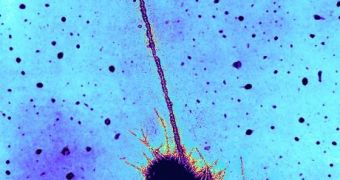Sex is as old as bacteria are.
Now, a team at the University of California-Davis has developed a mathematical model of the speed of the bacterial sex. The model could help researchers in determining the spread of important bacterial traits. The gene transfer between bacteria determines the bacterial adaptation and evolution; but this is a double-edged sword. Beneficial bacteria can determine positive environmental outcomes, like bioremediation qualities, but potentially harmful bacteria can increase the resistance to the antibiotics.
A real-life model of bacterial gene transfer would explain the speed of the bacteria's adaptation to the environment. The major bacterial sex mechanism is conjugation. Donor bacteria cells act like vampires, binding onto nearby non-related bacteria cells. The donor bacteria's "bite" introduces its own DNA into the recipient, triggering it to turn into a donor.
But the rates and the kinetics of conjugative gene transfer are not known.
The new research focused on biofilms, a layer formed by growing bacterial colonies. "While scientists have studied [conjugation] in the lab, and wondered about its impact in nature, current computer models of conjugation were pretty basic," said co-authors Timothy Ginn.
The new model incorporates wait times linked with conjugations, bacterial cell motion speed and transport in ground water, and the soil surfaces colonization by bacteria. These factors were added to previously established conceptual framework of conjugation in an isolated environment.
The improved mathematical model focuses on subsurface bacteria colonizing surfaces, like sand and soil grains. The bacterial transport and surface colonization is as important for spreading bacterial genes like as the conjugation itself. "It is important to consider all natural processes together when trying to predict rates of gene transfer," said Ginn.
"The model gives us a new tool for designing new experiments that reflect gene transfer in the real world, including such things as transport of cells in porous media of soils and aquifers. It also can be used for 'extrapolative' modeling to predict rates of gene transfer in certain cases, mainly environmental science scenarios, but also with relevance to some medical scenarios", explained co-author Arash Massoudieh.

 14 DAY TRIAL //
14 DAY TRIAL //